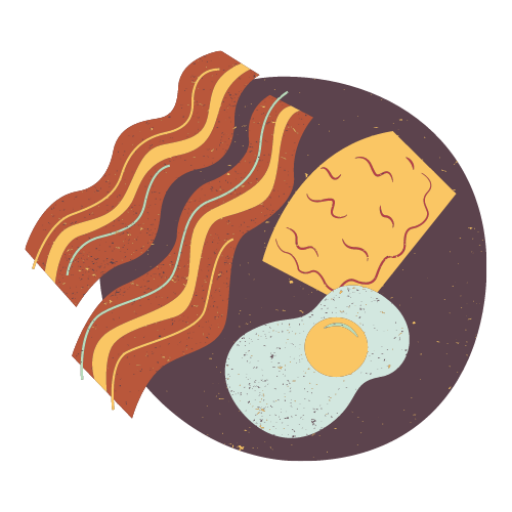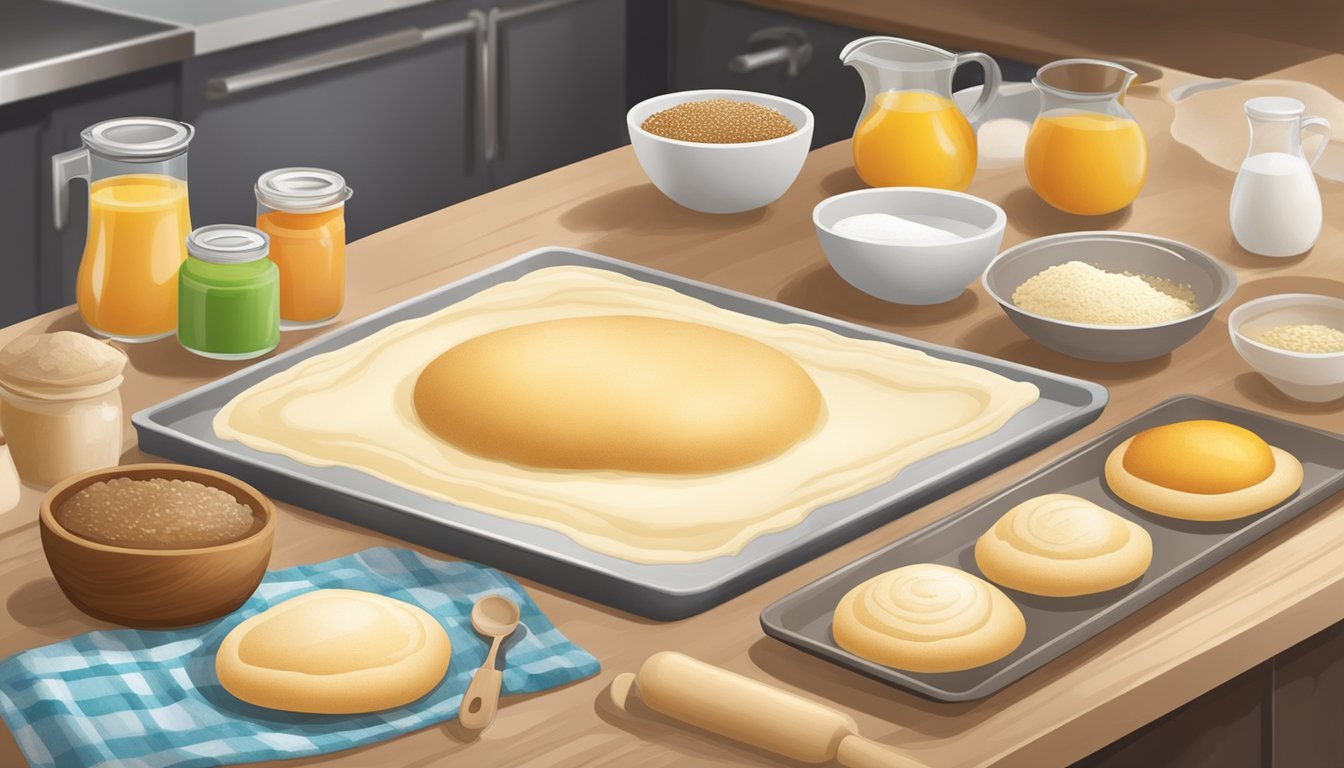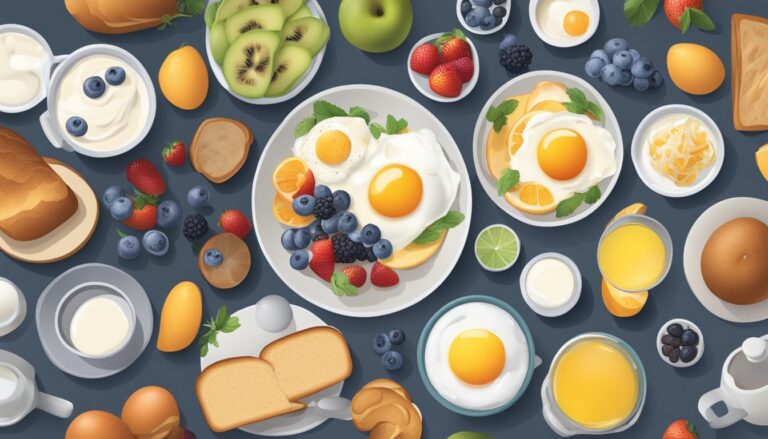Kolaches, a beloved Texas breakfast staple, have a rich history rooted in Czech immigrant traditions. These soft, pillowy pastries filled with savory or sweet ingredients have become an iconic part of the Lone Star State’s culinary landscape. Making homemade breakfast kolaches allows you to customize flavors and experience the joy of crafting this delicious treat in your own kitchen.
The process of creating kolaches from scratch involves preparing a yeast-based dough, allowing it to rise, and then shaping it around various fillings. Popular breakfast kolache fillings include sausage, eggs, cheese, and hash browns. Some recipes call for preparing a “sponge” the night before, which helps develop flavor and texture in the final product.
While kolaches may seem intimidating to make at home, they are quite approachable with the right techniques. By mastering a few key steps like proper kneading, resting the dough, and sealing the fillings, anyone can create these satisfying breakfast pastries. Homemade kolaches offer a taste of Texas tradition and the opportunity to experiment with different flavor combinations.
The History and Significance of Kolaches

Kolaches have a rich history rooted in Czech culture and have become an integral part of Texas cuisine. These sweet pastries have evolved from traditional Czech treats to beloved breakfast staples across the Lone Star State.
Czech Roots and Migration
Kolaches originated in the Czech Republic as a cherished pastry. Czech immigrants brought this culinary tradition to Texas in the mid-1800s during a significant wave of migration. These newcomers settled in central Texas, establishing communities that preserved their cultural heritage.
The original kolaches were round pastries filled with fruit, poppy seeds, or cheese. Czech families passed down recipes through generations, maintaining the authenticity of this beloved treat.
Popularity in the Lone Star State
Texas embraced kolaches, adapting them to local tastes. The pastry’s popularity spread beyond Czech communities, becoming a statewide phenomenon. Bakeries and cafes across Texas began offering kolaches, often with unique regional twists.
Texas kolaches expanded beyond traditional sweet fillings. Savory versions emerged, featuring sausage, cheese, and jalapeños. This fusion of Czech and Texan flavors created a distinct culinary identity.
Many towns in Texas celebrate their Czech heritage with kolache festivals, drawing thousands of visitors annually.
Kolaches as a Breakfast Treat
Kolaches transitioned from occasional treats to everyday breakfast fare in Texas. Their portability and versatility made them ideal for busy mornings. Texans of all backgrounds now enjoy kolaches as a quick, satisfying breakfast option.
Bakeries often offer a wide variety of kolache flavors, from classic fruit-filled to innovative savory combinations. Some establishments specialize solely in kolaches, highlighting their importance in Texas breakfast culture.
The popularity of kolaches has spread beyond Texas, with many discovering these pastries as a delightful alternative to typical breakfast foods.
Essential Ingredients for Kolache Dough

Creating delicious kolaches starts with selecting high-quality ingredients for the dough. The right combination of flour, yeast, and fats forms the foundation for soft, flavorful kolaches.
Choosing the Right Flour
All-purpose flour is the go-to choice for kolache dough. It provides the ideal protein content for a tender yet structured crumb. Look for unbleached all-purpose flour for the best flavor.
Bread flour can be used for a chewier texture, while pastry flour results in a more delicate crumb. Some bakers blend different flours to achieve their desired consistency.
For gluten-free options, try a 1:1 gluten-free flour blend designed for yeasted doughs. These often contain xanthan gum to mimic gluten’s elasticity.
Types of Yeast and Their Uses
Active dry yeast and instant yeast are the most common choices for kolache dough. Active dry yeast requires proofing in warm liquid before use. It’s ideal for longer rise times and develops complex flavors.
Instant yeast can be mixed directly into dry ingredients. It works faster than active dry yeast and is suitable for quicker recipes.
Fresh yeast, while less common, imparts a distinct flavor to kolaches. It’s perishable and needs to be dissolved in liquid before use.
| Yeast Type | Proofing | Rise Time | Flavor Development |
|---|---|---|---|
| Active Dry | Required | Longer | More complex |
| Instant | Optional | Shorter | Mild |
| Fresh | Required | Medium | Distinct |
The Role of Fats in the Dough
Fats are crucial for creating tender, flaky kolaches. Unsalted butter is the traditional choice, providing rich flavor and a melt-in-your-mouth texture.
Vegetable oil or shortening can be used for a softer dough that stays fresh longer. These fats also make the dough easier to work with.
Eggs contribute to the dough’s richness and help create a golden-brown crust. They also add structure and improve the dough’s ability to hold fillings.
For vegan options, plant-based butter or coconut oil can be substituted. These alternatives may alter the flavor slightly but still produce delicious results.
Preparing the Kolache Dough
Making kolache dough requires precision and patience. The key steps involve mixing ingredients, kneading the dough, and allowing proper fermentation time.
Mixing the Ingredients
Start by activating the yeast in warm water. Mix 1 1/2 cups flour, sugar, and salt in a large bowl. In a separate pan, heat water, sour cream, and butter to 120-130°F. Gradually add this warm mixture to the dry ingredients.
Beat at medium speed for 2 minutes to combine thoroughly. Add eggs and lemon zest for flavor. Incorporate the remaining flour gradually until a soft dough forms.
Kneading and Resting the Dough
Knead the dough on a lightly floured surface for 7-10 minutes. The goal is a smooth, elastic consistency. Place the dough in a greased bowl, cover with a damp cloth, and let it rise in a warm, draft-free area for about an hour.
After the initial rise, punch down the dough and divide it into 36 pieces. Shape each piece into a ball and arrange on a greased baking sheet, leaving space between them.
Understanding Dough Fermentation
Fermentation is crucial for developing flavor and texture. Let the dough balls rise for 15-20 minutes. This second rise allows the yeast to produce more carbon dioxide, creating a lighter texture.
Temperature affects fermentation speed. Warmer environments speed up the process, while cooler temperatures slow it down. Aim for a consistent room temperature around 75°F for optimal results.
Over-fermentation can lead to a sour taste and collapsed structure. Watch for the dough to double in size as a sign of proper fermentation. Adjust rising times based on your kitchen’s conditions.
Creating the Perfect Fillings
The key to delicious kolaches lies in their fillings. A variety of sweet and savory options can elevate these breakfast pastries to new heights.
Savory Fillings: Cheese and Sausage
Cheese fillings are a classic choice for kolaches. Cheddar cheese provides a sharp, tangy flavor that pairs well with the soft dough. For a richer taste, combine cheddar with cream cheese.
Breakfast sausage is another popular option. Cook and crumble the sausage before adding it to the kolache. For extra flavor, mix in sautéed onions or bell peppers.
Experiment with combinations like jalapeño and cheddar for a spicy kick. Spinach and feta offer a Mediterranean twist. Ricotta cheese mixed with herbs creates a light, creamy filling.
Sweet Fillings: Fruit and Cream Cheese
Fruit fillings bring natural sweetness to kolaches. Use homemade jam or cooked fruit compotes for the best flavor. Popular choices include apricot, blueberry, and cherry.
Cream cheese fillings offer a tangy-sweet taste. Mix softened cream cheese with sugar and a touch of vanilla extract. For variety, add lemon zest or a swirl of fruit preserves.
Traditional poppy seed filling is made by grinding poppy seeds and mixing them with honey, milk, and butter. This creates a unique, nutty flavor that’s beloved in Czech baking.
Innovative Filling Ideas
Think beyond traditional options to create unique kolaches. Try savory-sweet combinations like bacon and maple syrup. Use unexpected ingredients like pesto and mozzarella for an Italian-inspired version.
Dessert-inspired fillings can transform kolaches into sweet treats. Consider options like chocolate and hazelnut spread, or cinnamon apple pie filling.
For a breakfast twist, try scrambled eggs with cheese and herbs. Vegetarian options like roasted vegetables with goat cheese appeal to health-conscious eaters.
Assembling and Baking Kolaches

Assembling and baking kolaches requires careful attention to detail. The process involves shaping the dough, adding fillings, and applying finishing touches before baking to golden perfection.
Shaping and Filling the Dough
Roll out the prepared kolache dough on a lightly floured surface. Cut it into 3-inch squares for savory kolaches or 2-inch circles for sweet versions. Place a spoonful of filling in the center of each piece.
For savory kolaches, wrap the dough around sausage pieces or scrambled eggs. Pinch the seams to seal completely. For sweet kolaches, create a small indentation in the center of each circle and fill with fruit or cream cheese.
Place the shaped kolaches on a baking sheet lined with parchment paper, leaving space between each one for expansion during baking.
Applying the Egg Wash and Toppings
Prepare an egg wash by beating an egg with a tablespoon of water. Brush this mixture gently over the surface of each kolache using a pastry brush. This will give the finished product a shiny, golden appearance.
For sweet kolaches, sprinkle streusel topping over the fruit filling. To make streusel, mix equal parts flour, sugar, and cold butter until crumbly. For savory versions, add a sprinkle of shredded cheese if desired.
Let the kolaches rest for 10-15 minutes before baking to allow the dough to rise slightly.
Baking to Golden Perfection
Preheat the oven to 375°F (190°C). Place the baking sheet with prepared kolaches on the middle rack. Bake for 15-20 minutes, rotating the pan halfway through for even browning.
Watch closely as baking times may vary. The kolaches are done when they’ve risen and turned a rich golden brown color. The internal temperature should reach 190°F (88°C) for fully cooked dough.
Remove from the oven and brush with melted butter for extra flavor and shine. Let cool on the baking sheet for 5 minutes before transferring to a wire rack. Serve warm for the best taste and texture.
Finishing Touches and Serving Suggestions

Elevate your homemade breakfast kolaches with appealing garnishes and complementary pairings. The final presentation enhances both visual appeal and flavor, transforming these pastries into a complete morning meal.
The Art of Garnishing Kolaches
Sprinkle powdered sugar over sweet kolaches for a classic finish. A light dusting adds sweetness and visual appeal. For fruit-filled varieties, add a small dollop of vanilla-infused whipped cream.
Savory kolaches benefit from a sprinkle of fresh herbs. Chives or parsley complement egg and cheese fillings. For meat-filled kolaches, a dash of paprika or cracked black pepper adds color and flavor.
Consider a citrus glaze for fruit kolaches. Mix powdered sugar with lemon juice and zest for a tangy topping. Brush it on while the kolaches are still warm for a glossy finish.
Pairing Kolaches with Other Breakfast Items
Serve kolaches alongside crispy hash browns for a satisfying texture contrast. The savory potatoes complement both sweet and savory kolache varieties.
Offer a selection of fresh fruits to balance the richness of kolaches. Berries or citrus segments provide a refreshing counterpoint.
For a heartier breakfast, pair kolaches with crispy bacon strips. The smoky flavor enhances savory kolaches and provides a pleasant contrast to sweet ones.
Consider serving kolaches with cinnamon rolls for a indulgent breakfast spread. The combination offers a variety of textures and flavors, appealing to different preferences.
Accompany kolaches with a selection of spreads like butter, jam, or cream cheese. These allow diners to customize their kolaches to taste.
Storing and Reheating Kolaches

Proper storage and reheating techniques are crucial for maintaining the taste and texture of kolaches. These methods ensure you can enjoy these delicious stuffed breads at their best, even days after baking.
How to Keep Kolaches Fresh
Store kolaches in an airtight container at room temperature for 1-2 days. For longer storage, refrigerate for up to 5 days. Place parchment paper between layers to prevent sticking.
Freeze kolaches for up to 3 months. Wrap each one individually in plastic wrap, then place in a freezer-safe bag or container. This method works well for both traditional kolaches and klobasnek (savory versions).
Allow frozen kolaches to thaw in the refrigerator overnight before reheating. This gradual thawing process helps preserve their texture.
Reheating Tips for Best Quality
Oven reheating produces the best results. Preheat the oven to 350°F (175°C). Place kolaches on a baking sheet lined with parchment paper.
Heat for 5-7 minutes if refrigerated, or 8-10 minutes if frozen. This restores the bread’s softness while crisping the edges slightly.
For a quicker option, use a microwave. Heat individual kolaches for 20-30 seconds on medium power. Be careful not to overheat, as this can make the bread tough.
To add moisture and prevent drying, place a small bowl of water in the oven while reheating. This creates steam, helping to keep the kolaches soft and fresh-tasting.




